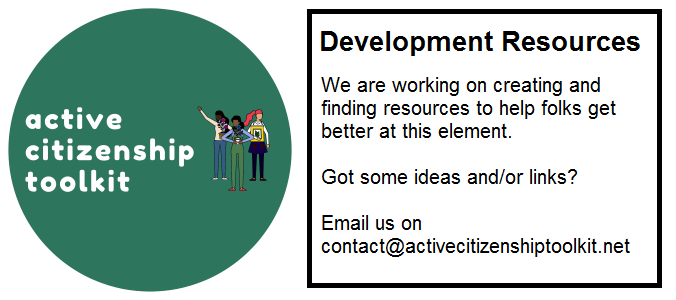Element Descriptor
We all want the world to be a Much Better Place sooner rather than later. We want to play our part. BUT… If your group goes up like a rocket and down like a stick you demoralise not just its members, but other groups and individuals who were hoping/needing it to stick around. You need to be able to spot any patterns (and underlying causes) of over-ambition/under-delivery, the likelihood of burnout, its symptoms, how to care for yourselves and sustain your collective active citizenship.
Level descriptors
| Novice | Practitioner | Expert | Ninja |
|---|---|---|---|
| Able to keep a sense of where individual and group morale is, anticipating peaks and troughs in response to predictable challenges to morale over time, and making suggestions to others about how morale can be maintained | Able to intervene to prevent individual and group troughs in morale becoming self-fulfilling/death spirals, choosing appropriate tools for discussion/action around the group’s identity, expectations and morale. | Able to help others identify likely and possible threats to morale, and take effective and efficient counter-measures to prevent de-motivation. Able to work with diverse members of multiple groups simultaneously to cope with existing and persistent demoralising factors (be they external or internal). | Able to work with others – both the hopeful and the pessimistic – in a group to pull a group out of a long-standing or sharp trajectory (circling the plughole) or, if it is necessary/unavoidable, to pull the plug in ways that makes future participation by individuals in social movement organisations more rather than less likely. |
Element Overview Essay
This is a draft. If something doesn’t make sense, or you see typos, or if you have further ideas, please email us on contact@activecitizenshiptoolkit.net
The reason this is often done so badly is that people seem to think that their own morale is their own business. And other people need to square that shit away. And so they’re shut out for the greater good of the group. And there’s no real language and social norms around this. Groups will often or have started doing these, frankly idiotic and at best useless at worst counterproductive “check ins” but they’re not the same thing.
And it’s a individualistic response to a sociological problem. Obviously also the problem with collective morale maintenance is that you might all know that the problem for the morale at the moment is, you know, one individual who’s not pulling their weight, or is being hypercritical or sensibly critical but in the wrong ways at the wrong time, or that they’re demanding too much of themselves demanding too much of other people. Or it might just be that your group is on a hiding to nothing because you’ve bitten off more than you can chew. You’ve underestimated the strength and determination of your opponents. And you’ve overestimated the willingness to support you have other groups that you thought were your allies within the broader ecosystem.
So this is a real can of worms. So no wonder people stay away from it.
The consequences, of course, are that you don’t have the language and the structures to talk about maintaining collective morale, your collective morale is probably not going to be maintained. And low morale can be contagious. And this can lead to a very steep death spiral in a group.
So, what is to be done? I think if you’re going to talk about the emotions in the group and the group’s sense of its own future, you need to do it regularly. You need to do it non-tokenistically, so there is time to discuss the emotions, their implications, and to come up with possible solutions.
You need a couple of people within the group who are sensitive to this and are willing to stick their heads above the parapet occasionally and say, “Yeah, I know that we were going to talk about x today but I really feel from my sense of emails and conversations, that there are morale issues in this group that shouldn’t any longer be left, ignored or suppressed” and go from there.
See also abyss staring
Development Resources

Assessment Resources

